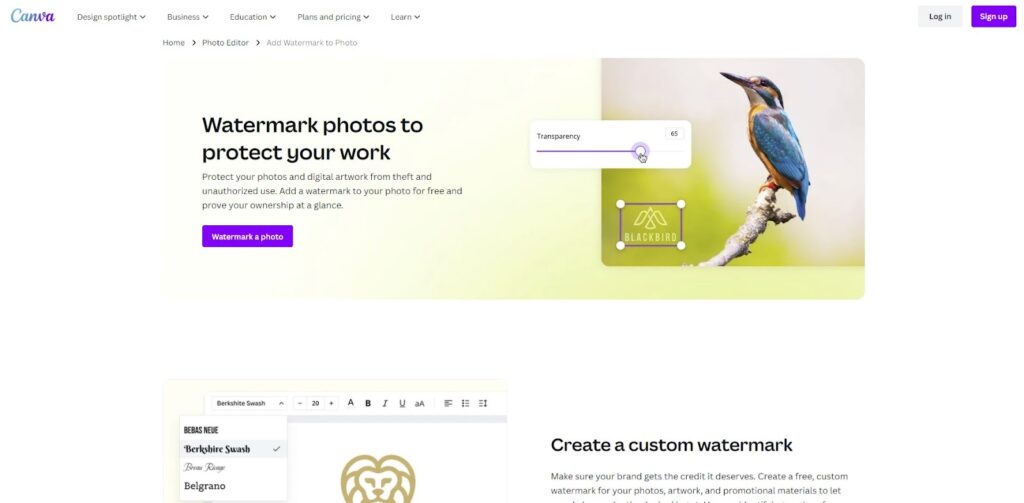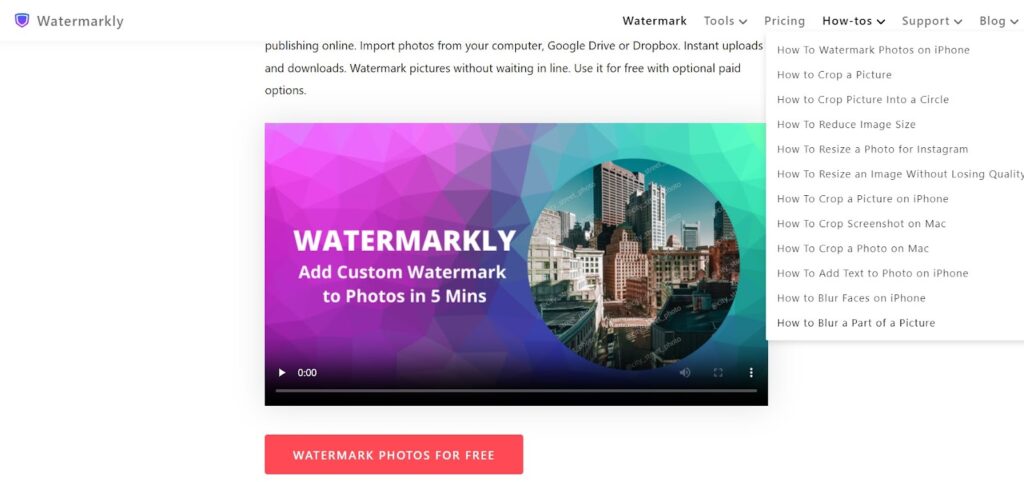7 Best Ways to Watermark Your Images Like a Pro: Never Let Steal Your Images

Getting photos stolen is the worst, and it happens way too often! Over 2 million images are taken every month without permission. Yikes!
Have you ever wondered how to watermark your images to protect your hard work?
Watermarking your images keeps them safe from theft. It’s a dependable safeguard for photographers and artists like you. Simply adding your logo or signature makes it way tougher for anyone to snatch your content.
When done right, watermarks blend in without wrecking your shot. Adding watermarks takes just minutes, thanks to awesome batch editing apps.
Here’s how to easily watermark images so you can rest easy.
Watermarks at a Glance
Regarding watermarking images, you have two main options— using text or using a logo. Both identify your work, but logos establish your brand.
Save those for your best pro shots to showcase your signature style. Simple text works for everyday pics.
Strategic placement is key—try fading your mark near the edges or corners so it blends. Make sure it’s legible but transparent enough that your pic shines through.
The goal dictates the details.
Selling prints online? Watermarking images keeps them from getting stolen.
Snapping family memories? Watermarking images make sure Aunt Sue doesn’t claim your work. Most professionals aim for simple and non-distracting marks.
Think clean fonts and modest sizes that integrate seamlessly. A killer watermark balances visibility with artistry while showcasing your brand identity.
How to Watermark Your Images in 7 Easy Steps
Have you got photos you want to protect? You can effortlessly watermark your images these days!
Here’s how to quickly mark up your shots using regular apps and software you already have. No fancy tools needed!
1. Custom Watermarks Using Adobe Photoshop
First, open the image you want to mark up in Photoshop. Head to Windows > Library to bring up your custom designs.

If you don’t already have one, no problem! Next, click the plus sign to create a new layer, then add your logo, written name, or other unique mark.
Here’s where you can get creative with fonts, shapes, and colors to design your unique watermark.
But don’t go overboard! Keep it simple so the focus stays on your fantastic photo. Once you’ve made your mark, turn down the opacity so it blends nicely into the background.
Save that watermark layer to the Cloud Library for another time. Go back to your image, choose Windows > Library again, and drag the watermark layer onto your picture as a separate layer.
You can resize and place the mark where you see fit. Export and unveil your newly protected image to the public!
Here’s a video with more context on how to watermark images using Adobe Photoshop:
2. Creating a Custom Watermark Online
When you need to add a personal touch to your images on the fly, use free DIY watermark tools like Canva, PicMonkey, or Fotor—they make the process painless.
With Canva, for instance, just upload the photo you want to protect to the editor, then slap on your logo, stylized name, or other visuals you want to associate with your work.

Next, have fun customizing the font, size, color, placement, etc., to showcase your one-of-a-kind flair! But don’t overdo the edits—you still want your image optimized for clarity. Just subtly leave your mark without being distracting.
Once you find that ideal balance between personal brand and fantastic photo, download the finished product in seconds. Viola!
Now, your photos will get proper credit when you share them, all thanks to the customized watermark you created in minutes for free.
3. Watermarking Photos with Apps
Adding watermarks to your pics is a breeze thanks to apps like Watermarkly and Imatag. They give you an easy way to protect all the phone photos you want to post online.

Open up your chosen watermark app and select the images from your camera roll that you want to secure with a watermark.
Got them picked? Okay, now tap on your preferred watermark from the options.
You’ll likely see premade watermark designs to choose from. We’re talking about your name in cursive font, creative symbols representing you, location stamps—lots of great stuff.
But you can also create a fully custom watermark if none of those presets fit your vibe.
Design your own by uploading a logo, icon, or stylized text. Then, play with the size, opacity, and placement over your photo till it looks just right.
When you have your watermarked images sitting pretty, tap save, and they’ll export right back into your camera roll, ready to upload wherever you want while giving you the credit you deserve.
Could phone photo watermarking get any easier? I think not!
4. Making a Watermark in Lightroom
The first thing you’ll want to do is create a new watermark template. In Lightroom, go to Edit > Edit Watermarks. This opens the Watermark Editor. Here, you can choose if you want a text or graphic watermark.

For a text watermark, simply type in the desired text in the preview area. Customize the font, size, alignment, and other text options to your liking. For a graphic, click Choose and navigate to the logo or image file you want to use.
Now, it’s time to adjust the actual watermark settings. You can play around with options like scale/size, opacity, positioning, and rotation to get it looking perfect in your photos.
Scale lets you enlarge or shrink it, while opacity adjusts transparency. Use inset and anchor to fine-tune placement.
Once your watermark looks good, save it by clicking the preset menu in the top left corner. Choose “Save Current Settings as New Preset” and give it a descriptive name. This preserves it for applying later.
Whenever you have photos selected that need your watermark, go to the Print module and enable the new preset. You’ll see it appear in all your images.
You can also batch apply your watermark by selecting multiple photos, enabling the watermark preset, then right-clicking and choosing “Export with Previous.” This will export fresh, watermarked copies in one batch!
Watch this video to learn more about adding custom watermarks using Adobe Lightroom:
5. Watermarking Images in Microsoft Word
Adding a watermark in Microsoft Word is an intelligent way to deter any sneaky misuse of your hard work.
Open up the document you want protected and click on the Design tab. In the menu, click “Watermark” and then choose “Custom Watermark” from the bottom of the list. This is where we customize our own instead of using a basic preset watermark.
You can pick either a picture or text watermark. If going the picture route, click the “Select Picture” button and pick your chosen logo or image file from your computer.
Size it up nicely on the preview. For simple text, type something like your business name, website, or copyright date.
Now, it’s time to get creative and dress up your watermark with different fonts, sizing, colors, and angles before slapping it on your doc. When it’s looking snazzy, hit OK—your brand-new custom watermark will appear faintly across all the pages.
See how it mixes in with your text and images. Depending on the look you’re going for, you should make the watermark darker or more transparent.
6. Image Watermark Ideas for Photographers
When choosing watermarks for your photography, simple is often the most effective.
A clean text watermark with your business name or website in one corner can clearly mark the images as yours without overwhelming the photo.
Use classic fonts like Arial or Times at about 20-30% opacity.
Another idea is to create a logo or icon that represents your brand. This should be a simple graphic or stylized initials that are easily recognizable.
Place it small in one of the lower corners. Stay away from generic icons and get creative with shapes and lines that feel cohesive with your brand style.
You can also add photographic elements like light leaks, film grain or bokeh textures that organically blend into the image.
Use these sparingly in darker-toned areas. They can reinforce style but shouldn’t demand attention.
The goal with watermarks is subtle but clear recognition without distracting from the artistry of the photograph itself. Strategic size, positioning, and opacity will ensure the focus stays on your images.
Subtlety wins the day! Start with your name/website, and if you want to get creative, use supportive graphic elements in moderation.
7. Watermark Your Images Using Free Watermark Software
Programs like Visual Watermarker make it easy to get consistent watermarks on all your pictures quickly.
Just drag your chosen folder of images into the software and pick or customize your ideal watermark from there.
We’re talking overlays with your logo, website, name, copyright—whatever unique stamp you want to plaster on your hard work! Tinker around with font, size, color, and placement till it looks fab layered on top of the photo previews.
Once your watermark is sitting pretty where you want it, hit apply and watch the magic happen.
The software will work its automation wizardry, flawlessly adding your custom watermark on every single pic in that folder. We love efficiency!
You can also set advanced settings so different folders get different watermarks, tweak individual watermarks first, export different file types, or do whatever you need. Talk about easy batch work!
So next time you’re facing a 500 photo album that needs your fancy schmancy watermark, let the software take the wheel and save you hours of mind-numbing work.
Conclusion
And there’s the full scoop, folks!
You now have pro-grade tips to subtly watermark images as your creative property without mucking up their visual stories.
We covered the text/logo basics to assert authorship professionally while maintaining photographic artistry.
You understand streamlined apps to customize and apply watermarks in batches. Automation handles extensive galleries so that you can save hours of work.
Blend those discrete touches into your pixel masterpieces. Enable frictionless sharing without concern over attribution or misuse.
Now, you can spotlight your images to the world while staking claim over your visuals.